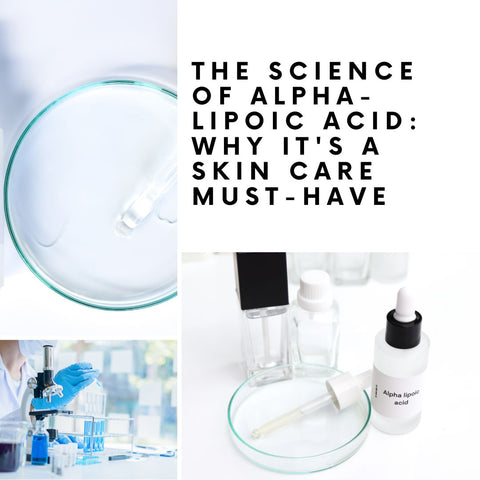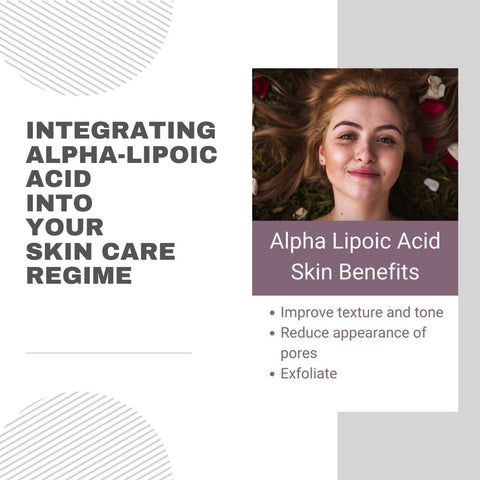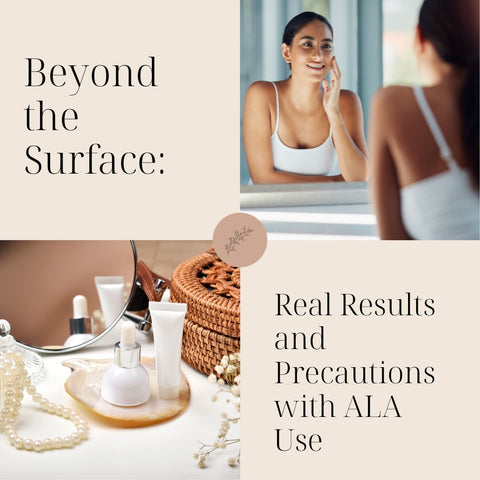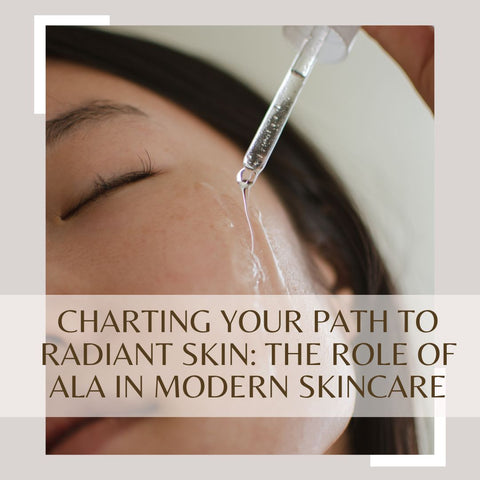Alpha-lipoic acid (ALA) shows promise as a revolutionary skincare ingredient. This potent antioxidant is both water- and fat-soluble, allowing it to penetrate both lipid-rich cell membranes and the watery interiors of cells. This property enables ALA to protect against a wide range of free radicals, making it especially effective in combating oxidative stress-induced signs of ageing. In skincare, ALA's ability to reduce inflammation and oxidative damage makes it an effective tool for addressing fine lines, wrinkles, and uneven skin tone. Furthermore, ALA has been shown to promote cellular energy production, which can lead to a more youthful and radiant complexion.
Alpha-Lipoic Acid Explained is likely to be an informative and engaging resource for those interested in learning about the role of alpha-lipoic acid (ALA) in skincare. This blog could provide a comprehensive overview of ALA's properties, mechanisms of action, and potential skin benefits, which may include:
-
Describes how ALA works as a powerful antioxidant, neutralising free radicals and protecting skin cells from oxidation.
-
Describes the specific benefits of ALA for the skin, such as reducing wrinkles, improving texture, and promoting a more even tone.
-
Investigating how ALA works at the cellular level in the skin, including its ability to penetrate cell membranes and promote cellular energy production.
-
Scientific research and clinical studies demonstrate the efficacy of ALA in skincare, including its effects on wrinkles, fine lines, and other common skin concerns.
-
Instructions on how to incorporate ALA into a skincare routine, include tips on selecting products with stable ingredient concentrations and best application techniques.
-
Exploring how ALA can be combined with other skincare ingredients, such as vitamins C and E, to boost its antioxidant properties and overall benefits.
-
Discuss any potential side effects or interactions associated with the use of ALA in skincare, as well as precautions for people with certain skin conditions or sensitivities.
-
Discussing emerging trends and research directions in ALA-based skincare, such as novel formulations and applications.
The Science of Alpha-Lipoic Acid: Why It's a Skin Care Must-Have

The science of alpha-lipoic acid would most likely look at the scientific basis for alpha-lipoic acid (ALA) and its remarkable skin health benefits. Here's an example of what such a discussion might include:
-
ALA's unique ability to function as a powerful antioxidant will be highlighted. The blog could explain how ALA fights oxidative stress by scavenging free radicals, and shielding skin cells from damage caused by environmental aggressors such as UV light and pollution.
-
The role of ALA in cellular energy production, specifically its involvement in the mitochondrial energy-generating process, will be investigated. Readers could learn how this function helps to maintain skin vitality and promote a youthful appearance.
-
The anti-inflammatory properties of ALA will also be highlighted. This study investigates how ALA can reduce redness, soothe irritation, and potentially treat conditions such as acne and rosacea.
-
The ability of ALA to promote collagen production would most likely be discussed in depth. Collagen is essential for skin elasticity and firmness, and ALA's ability to promote collagen synthesis could be highlighted as a key aspect of its anti-aging properties.
-
Another potential application for ALA is to brighten the skin and even out the tone. This could explain how ALA inhibits melanin production, which reduces hyperpigmentation and promotes a more radiant complexion.
-
Scientific studies and clinical trials that demonstrate the efficacy of ALA in skincare will be cited and examined. This section could give readers concrete evidence of ALA's benefits and boost its credibility as a skincare ingredient.
-
Practical advice on choosing and using ALA-containing skincare products will be provided. This could include advice on selecting stable formulations, incorporating ALA into a daily skincare regimen, and exploring potential synergies with other ingredients.
Unveiling ALA: A Potent Antioxidant for Skin Health
A Potent Antioxidant for Skin Health sounds like an intriguing look at alpha-lipoic acid (ALA) and its profound effects on skincare. Here's an example of what this unveiling could entail:
-
The blog delves into ALA's antioxidant mechanisms, demonstrating how it neutralises free radicals, protects against oxidative stress, and promotes skin health and vitality.
-
This explains how ALA's ability to penetrate both the lipid and aqueous compartments of cells enables it to provide comprehensive protection to skin cells against environmental damage.
-
ALA promotes collagen synthesis, reduces fine lines and wrinkles, and improves skin firmness and elasticity.
-
When discussing ALA's ability to inhibit melanin production, the blog would emphasise how it helps fade dark spots, hyperpigmentation, and uneven skin tone, resulting in a brighter and more uniform complexion.
-
Exploring ALA's anti-inflammatory properties, this explains how it soothes redness, calms irritation, and alleviates conditions like acne and rosacea, making it suitable for sensitive skin types.
-
Presenting scientific research and clinical studies, this provides evidence supporting the efficacy of ALA in skincare, giving readers confidence in its benefits.
-
Formulation Insights: Offering insights into the formulation of ALA-containing skincare products, this guide readers on selecting high-quality products with stable concentrations of ALA for optimal results.
-
By providing practical tips for incorporating ALA into a skincare routine, this would empower readers to leverage the benefits of this potent antioxidant for their skin health.
The Dual Action of ALA: Anti-Aging and Anti-Inflammatory Benefits
Alpha-lipoic acid is a fatty acid that our bodies naturally produce. ALA aids the body's conversion of nutrients into energy and is an effective antioxidant that protects our cells, reduces inflammation, and slows the ageing process. It also has the potential to alleviate chronic illnesses that are commonly connected with ageing.
ALA and Skin Repair: From Fine Lines to Firmness
ALA effectively combats the damage that causes collagen depletion, potentially slowing the process of skin ageing. So, if you have wrinkles, lines, under-eye bags, puffiness, enlarged pores, acne scars, or dull skin, Alpha-Lipoic Acid products are right for you.
Integrating Alpha-Lipoic Acid into Your Skin Care Regime

Integrating alpha-lipoic acid (ALA) into your skincare routine can be beneficial because of its antioxidant properties and potential to improve your skin's overall health and appearance. Here's how to incorporate it:
-
Alpha-lipoic acid is a potent antioxidant that combats free radicals, reduces inflammation, and improves the appearance of fine lines and wrinkles. It has the potential to enhance skin texture and tone.
-
Look for skincare products with alpha-lipoic acid. These may include serums, creams, or moisturisers. Make sure the product is from a reputable brand and has positive reviews.
-
Before using any new product containing alpha-lipoic acid on your face, conduct a patch test on a small area of your skin to check for any adverse reactions or sensitivities.
-
Begin by using alpha-lipoic acid-containing products once or twice a week to allow your skin to adjust. Gradually increase the frequency if your skin tolerates it.
-
Always adhere to the instructions provided by the product manufacturer. This includes determining how much product to use and whether to apply it in the morning, evening, or both.
-
Alpha-lipoic acid can make you more sensitive to the sun, so use sunscreen every day, especially if you are using products with this ingredient.
-
Certain skincare ingredients, such as acids or retinoids, may not be effective when combined with alpha-lipoic acid. If you are unsure about combining different skincare products, consult with a dermatologist.
-
Pay attention to how your skin reacts to the alpha-lipoic acid-containing product. If you experience irritation or adverse effects, stop using the product and see a dermatologist.
-
It may take some time to see noticeable results from this skincare ingredient, just like any other. Consistency is key, so stick to your skincare routine and allow the product to work.
-
If you have any specific skin concerns or conditions, such as acne or rosacea, you should consult with a dermatologist before adding alpha-lipoic acid to your skincare routine. They can make personalised recommendations based on your skin type and concerns.
Optimal Usage: How to Incorporate ALA for Maximum Benefits
To optimise the benefits of alpha-lipoic acid (ALA) in your skincare routine, consider the following tips:
-
Cleanse Your Skin: Begin by using a gentle cleanser to remove dirt, oil, and impurities from your skin. This lays the groundwork for the most effective ALA absorption.
-
Apply ALA-Containing Product: After cleansing, use a tiny amount of your preferred skincare product that contains alpha-lipoic acid. This may be a serum, cream, or moisturiser. Follow the manufacturer's directions for the amount to use and application frequency.
-
Target Specific Areas: If you have specific areas of concern, such as fine lines around the eyes or wrinkles on your forehead, you can apply the ALA-containing product directly to them.
-
Allow Absorption Time: Give the ALA-containing product some time to absorb into your skin before applying any other skincare products. This enables the active ingredients to penetrate effectively.
-
Consider Layering: If you use multiple skincare products, layer them properly for maximum efficacy. Typically, products should be applied from thin to thick. ALA-containing products can typically be used before heavier creams or oils.
-
Use Sunscreen During the Day: Alpha-lipoic acid may increase sun sensitivity, so it's crucial to apply a broad-spectrum sunscreen with SPF 30 or higher during the day. This helps to protect your skin from harmful UV rays and prevents sun damage.
-
Combine with Antioxidants: To maximise antioxidant benefits, combine alpha-lipoic acid with other antioxidants such as vitamin C or vitamin E. This combination can have synergistic effects, increasing overall protection against environmental damage.
-
Adjust Frequency Depending on Tolerance: Pay attention to how your skin reacts to the ALA-containing product. If you experience irritation or sensitivity, reduce the frequency of use or stop using it temporarily. However, if your skin tolerates it well, you can gradually increase the frequency of application.
-
Maintain Consistency: In the world of skincare, consistency is essential. Incorporate alpha-lipoic acid into your daily routine and use it regularly to achieve the best long-term results.
-
Consult a Dermatologist: If you are unsure about incorporating alpha-lipoic acid into your skincare routine or if you have specific skin conditions, see a dermatologist for personalised recommendations and guidance. They can help you create a skincare regimen that is tailored to your specific needs and concerns.
Choosing the Right ALA Products: Creams, Serums, and Supplements
Creams, Serums, and Supplements provide a practical guide to help readers choose the best alpha-lipoic acid (ALA) products for their skincare needs. Here's how the book could explain the decision-making process:
-
Begin by explaining the various ALA product formulations on the market, which include creams, serums, and supplements. Describe each type's distinct characteristics and how they may influence efficacy and suitability for specific skincare concerns.
-
Explore ALA creams and moisturizers, emphasising their hydrating properties and ability to deliver ALA to the skin's surface. Discuss the advantages of ALA creams for reducing dryness, fine lines, and improving overall skin texture.
-
Examine ALA serums for their lightweight texture and high concentration of active ingredients. Discuss how ALA serums penetrate deeply into the skin, making them effective at treating specific issues like wrinkles, hyperpigmentation, and uneven skin tone.
-
Discuss ALA supplements, including how they are taken orally to provide systemic antioxidant support. Highlight the potential benefits of ALA supplements for promoting skin health from within, such as their ability to combat oxidative stress and inflammation.
-
Provide practical advice for selecting the best ALA product based on personal skincare requirements, preferences, and lifestyle factors. Discuss important factors to consider, such as skin type, specific concerns, ingredient compatibility, and budget.
-
Choose high-quality ALA products from reputable brands to ensure potency, efficacy, and safety. Provide instructions for reading product labels, verifying certifications, and conducting research on product reviews and customer feedback.
-
Discuss the potential benefits of combining various ALA products, such as using a cream during the day for surface hydration and protection and a serum at night for deeper treatment and repair.
-
Encourage readers to seek personalised recommendations from a dermatologist or skincare professional, particularly if they have specific skin concerns or medical conditions.
Tailoring ALA Use: Adjustments for Different Skin Types
Adjustments for Different Skin Types is a guide that helps readers tailor their alpha-lipoic acid (ALA) skincare routine to their specific skin type and needs. Here's how the book could provide personalised recommendations:
-
Begin by explaining the various skin types—dry, oily, combination, sensitive, and mature—and how each has unique characteristics and concerns.
-
Discuss how ALA can help dry skin by providing hydration, increasing collagen production, and lowering oxidative stress. Consider using creamy ALA formulations or combining ALA products with moisturisers containing hydrating ingredients such as hyaluronic acid or glycerin.
-
Explain how ALA's antioxidant and anti-inflammatory properties can help regulate oil production and prevent acne breakouts. Use lightweight ALA serums or gel-based formulations that will not clog pores, and avoid heavy creams and oils.
-
Provide strategies for balancing the needs of combination skin, which can vary depending on the area of the face. To effectively address specific concerns, use ALA products selectively, for example, serums on oily areas and creams on dry areas.
-
Address any concerns about ALA-related irritation or sensitivity, particularly in people with sensitive skin. Before widespread use, start with lower ALA concentrations and patch-test the product. Also, choose gentle formulations with no added fragrances or harsh ingredients.
-
Highlight ALA's anti-aging properties for mature skin, including its ability to reduce fine lines, wrinkles, and age spots. To maximise efficacy, incorporate ALA products into a comprehensive anti-aging skincare routine that includes other ingredients such as retinoids and peptides.
-
Discuss how the frequency of ALA use varies based on skin type and tolerance. Begin with a low frequency, such as every other day or a few times per week, and gradually increase as tolerated.
-
Encourage readers to monitor how their skin reacts to ALA products over time and make adjustments as necessary. Emphasize the value of consistency and patience in achieving desired results.
Beyond the Surface: Real Results and Precautions with ALA Use

This comprehensive guide delves deeper into the practical advantages and risks of using alpha-lipoic acid (ALA) in skincare. Here's how the blog could go into these aspects:
-
Begin by presenting real-life testimonials and case studies that demonstrate the transformative effects of ALA on skin health. Highlight success stories of people who have seen improvements in skin texture, tone, and overall appearance since incorporating ALA into their skincare routines.
-
Discuss scientific research and clinical studies that back up the efficacy of ALA in skincare. Provide summaries of key findings and highlight notable studies that show ALA's ability to reduce oxidative stress, fight ageing, and improve a variety of skin conditions.
-
Include before and after photos to visually demonstrate the visible improvements made possible by using ALA. Showcase examples of wrinkle reduction, hyperpigmentation reduction, and increased skin radiance to demonstrate the tangible results that can be obtained over time.
-
Discuss any potential risks and side effects associated with ALA use. Discuss common issues like skin irritation, sensitivity reactions, and interactions with other skincare products or medications. Explain how to reduce risks and mitigate negative effects.
-
Emphasise the importance of running a patch test before using ALA products extensively. Before applying ALA products to larger areas of the skin, follow step-by-step instructions for performing a patch test and monitoring for any adverse reactions.
-
Discuss the possibility of increased sun sensitivity associated with ALA use. To reduce the risk of sunburn and sun damage, readers should use sunscreen daily and take additional sun protection measures such as wearing protective clothing and seeking shade.
-
Before incorporating ALA into a skincare regimen, consult with a dermatologist or skincare professional, particularly if you have sensitive skin, underlying medical conditions, or are concerned about possible interactions.
-
Discuss the importance of long-term consistency and adherence to an ALA-containing skincare routine. Encourage readers to be patient and persistent on their skincare journey, as significant improvements may take time to show.
Evidence-Based Outcomes: What Research Says About ALA
Alpha-lipoic acid (ALA) in skincare research is still in its early stages, but several studies have looked into its possible benefits. Here are some evidence-based results from the research:
-
Antioxidant Properties: ALA is an effective antioxidant that can neutralise free radicals, which can harm skin cells and contribute to ageing. Studies have indicated that alpha-lipoic acid (ALA) could potentially shield the skin from oxidative stress resulting from external elements like pollution and UV radiation.
-
Anti-inflammatory Effects: Inflammation is a factor in many skin conditions, including acne, eczema, and psoriasis. ALA has been shown to have anti-inflammatory properties, which may help reduce the redness, swelling, and irritation associated with these conditions.
-
Anti-aging Benefits: Several studies suggest that ALA may have anti-aging properties for the skin. Studies have demonstrated that ALA can enhance the texture of the skin and reduce the appearance of wrinkles and fine lines. Moreover, it might encourage the synthesis of collagen, which keeps skin smooth and youthful.
-
Hyperpigmentation: Some studies suggest that ALA may help reduce hyperpigmentation, such as dark spots and melasma. ALA has been shown to inhibit melanin production, resulting in a more even skin tone and reduced discoloration.
-
Wound Healing: ALA has been studied for its ability to promote wound healing and tissue repair. According to studies, ALA can speed up the healing process by reducing inflammation, increasing blood flow, and stimulating the production of collagen and other proteins required for skin regeneration.
-
Moisturising Properties: ALA has humectant properties, which means it attracts and retains moisture in the skin. This can help to hydrate and balance the skin's moisture levels, making it appear smoother and more supple.
-
Combination Therapy: Studies indicate that ALA may increase the potency of other skincare ingredients when combined, such as retinoids and vitamin C. The utilisation of combination therapy may yield synergistic benefits in enhancing different facets of skin health and appearance.
Listening to Your Skin: Managing Sensitivities and Expectations
The goal is to help readers incorporate alpha-lipoic acid (ALA) into their skincare routine while understanding their skin's unique needs and effectively managing expectations. Here's how they could approach the topic:
-
Begin by explaining skin sensitivities and their common triggers, which include environmental factors, genetic predispositions, and skincare ingredients. Encourage readers to pay attention to their skin's cues and recognise symptoms of irritation or intolerance.
-
Guide to determining individual tolerance to ALA products. Encourage readers to begin with a patch test and gradually incorporate ALA into their skincare regimen, closely monitoring their skin's response.
-
Set realistic expectations for the effectiveness of ALA skincare. It is important to note that, while ALA can provide significant benefits such as improved skin texture, tone, and radiance, noticeable changes may take time to appear, and results may vary depending on individual factors.
-
Gentle ALA formulations are recommended for readers with sensitive skin. Highlight products with low fragrance, alcohol, and potential irritants, and recommend patch testing before widespread use.
-
Discuss the significance of adjusting the frequency of ALA use according to individual skin tolerance. Encourage readers to listen to their skin and adjust their usage as needed to avoid overexfoliation or irritation.
-
Emphasise that when using ALA products, it is critical to keep skin hydrated and to support the skin's natural barrier function. Encourage using occlusives, moisturisers, and hydrating serums in your skincare regimen to help calm and shield your skin.
-
Remind readers that even with ALA products, daily sun protection is still important. Stress the importance of wearing broad-spectrum sunscreen with an SPF of 30 or higher to reduce the chance of sun damage and prevent sunburn, especially in light of the possibility that ALA may make people more sensitive to the sun.
-
Encourage readers to monitor their skin's progress over time and adapt their skincare regimen accordingly. Guide for assessing changes in skin texture, tone, and overall look to determine the efficacy of ALA products.
Future Directions: Emerging Trends in ALA Research and Products
The fascinating developments and possible inventions in alpha-lipoic acid (ALA) research and skincare product development are examined in Emerging Trends in ALA Research and Products. The following is how the book could foresee emerging trends:
-
Discuss the creation of new ALA formulations, such as microencapsulated ALA, to improve stability and target delivery. Investigate novel delivery systems, such as liposomes or nanoparticles, to improve ALA penetration and efficacy in skin.
-
Investigate new trends in combining ALA with other skincare ingredients to maximise its benefits. Highlight synergistic combinations with antioxidants such as vitamin C and E, peptides, hyaluronic acid, and botanical extracts to boost anti-aging and skin-rejuvenating properties.
-
Discuss the potential for personalised skincare formulations based on individual skin needs and genetic factors. Investigate the use of genetic testing and biomarker analysis to optimise ALA-based skincare regimens for maximum efficacy and personalisation.
-
Investigate the use of bioengineering and biotechnology in ALA research and product development. Discuss the use of biocompatible materials and tissue engineering techniques to create ALA-infused skincare products that have high bioavailability and skin compatibility.
-
Emphasise ongoing clinical trials and research studies into the efficacy of ALA in a variety of skincare applications. Discuss promising findings and potential breakthroughs in understanding ALA's mechanisms of action, as well as its effects on skin health and ageing.
-
Discuss the increasing importance of sustainability and ethical practices in skincare product development. Investigate environmentally friendly ALA sourcing and sustainable packaging options to reduce the environmental impact of ALA-based skincare products.
-
Investigate the incorporation of technology into ALA-based skincare solutions, such as smart skincare devices and digital platforms that provide personalised skincare recommendations.
Charting Your Path to Radiant Skin: The Role of ALA in Modern Skincare

"Charting Your Path to Radiant Skin: The Role of ALA in Modern Skincare" takes a comprehensive approach to obtaining radiant skin with ALA, allowing readers to navigate their skincare journey with confidence and expertise.









































